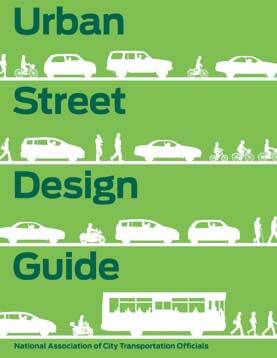The Urban Land Institute has endorsed the Urban Street Design Guide, published last year by the National Association of City Transportation Officials(NACTO). The guide embraces the unique and complex challenge of designing urban streets, aiming to make streets safe for people whether they are walking, biking, using transit, or driving.
The guide’s emphasis on making alternative transportation modes accessible and safe reflects a trend toward making cities more people-friendly and less car-focused, says Patrick L. Phillips, ULI chief executive officer. “Great cities start with great streets,” he said in announcing the endorsement. “This upends long-held notions about how people get around in cities, and offers practical, well-thought-out recommendations on how to make streets more inviting. ULI is pleased to endorse the publication as a useful tool in the creation of cities that are economically prosperous, environmentally conscious, and highly livable.”
The guide, available at nacto.org, provides a detailed set of design strategies for creating healthy urban streets, including language on lane widths, stormwater management, sidewalks, and complex intersections. Based on best practices from cities across the United States, it will be updated to reflect new and improved practices as they develop.
ULI’s endorsement of the guide is based on the recommendations of a ULI review committee composed of several members who serve on the Institute’s product councils, a network of the industry’s foremost land use and urban development experts. “The guide exemplifies excellence by being clear, coherent, and comprehensive, while promoting state-of-the-art street design and urban design,” says committee member James Moore, a member of ULI’s Urban Revitalization Council and a senior vice president of HDR in Tampa, Florida. “The guide is an incredible resource for ULI members and public officials.”
Other review committee members were Wes Guckert, president, the Traffic Group Inc., Baltimore, and member of the Public Development and Infrastructure Council; Jill Hatton, director of the University of Wisconsin Foundation Board; and member of the Urban Development and Mixed-Use Council; John Hempelmann, chairman, Cairncross and Hempelmann, Seattle, and member of the Transit-Oriented Development Council; Scott Mingonet, landscape architect, Kimley-Horn and Associates, Charlotte, North Carolina, and member of the Public-Private Partnership Council; Brad Power, director of economic development, Longmont, Colorado, and member of the Public-Private Partnership Council; and George Stanziale Jr., senior vice president and director of the Design Studio, Stewart Inc., Raleigh, North Carolina, and member of the Urban Development and Mixed-Use Council.
The review committee concluded that NACTO’s process for developing the guide, which drew on successful models that can be replicated, is consistent with ULI’s tradition of knowledge sharing and highlighting best practices. Committee members were also impressed with NACTO’s inclusion of interim solutions to improve pedestrian and cycling conditions while more permanent changes are designed. “Through the guide, NACTO is promoting a flexible, locally driven approach to street design policy,” Moore says.
The committee noted that by outlining alternatives to driving, the guide supports many of the goals of ULI’s Building Healthy Places Initiative, which highlights the role of well-planned urban design and development in creating communities that encourage healthy living. In addition, the guide’s recognition of well-designed streets as an economic asset is in accordance with ULI’s view of the factors that contribute to community prosperity and sustainability.
The committee recommended that ULI’s endorsement be used to raise awareness of the guide among ULI’s members, including tailored programming for the Institute’s district council network, which reaches nearly 29,000 members in more than 50 markets in the United States, and its product council network, which includes more than 2,000 members. ULI’s endorsement is the latest in a series of endorsements for the guide, including several from local and state departments of transportation, including the California Department of Transportation.
Gabe Klein, ULI senior visiting fellow and former head of the transportation departments for Chicago and Washington, D.C., endorsed the guide as commissioner of the Chicago Department of Transportation and continues to raise awareness of the publication as a member of NACTO’s strategic advisory board. “This design guide gives planners and engineers around the U.S. solid urban standards they can rely on, and which policy makers can count on for sustainable, safe, inviting, and therefore business- and people-friendly streets for current users and future generations,” Klein says.
Sarah Jo Peterson is ULI senior director, policy.






